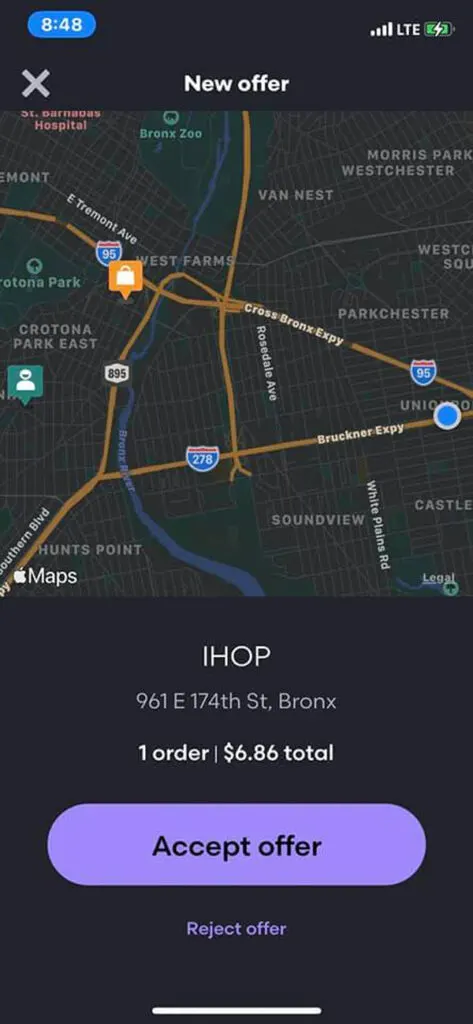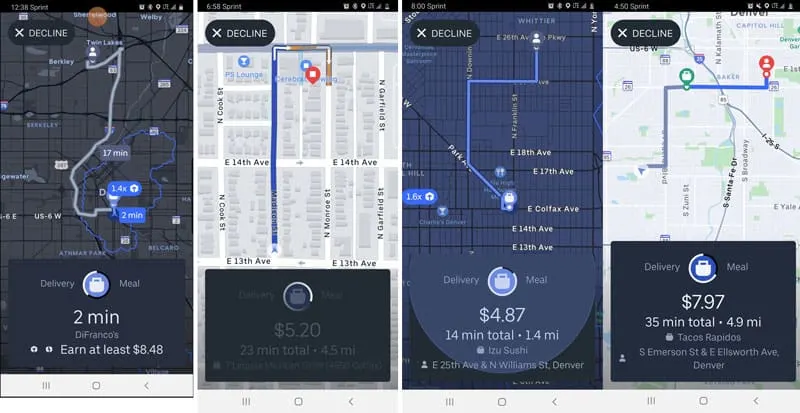Maybe you decided to give Grubhub a try. You get your first delivery offer.
Wait, what? Where are the miles?
Doordash and Uber Eats tell you how far a delivery will go. Doesn’t Grubhub do the same?
No. All you get is a map.
How do Grubhub drivers know how far they will go on a delivery if they aren’t show you the miles? Is it possible to make informed decisions on delivery offers? Does it mean that Doordash or Uber Eats are the better food delivery apps?

We’ll talk about all of this, and walk you through how to estimate your time and distance on Grubhub delivery offers. We’ll discuss:
- Does Grubhub show the mileage or distance on delivery offers?
- Is Grubhub starting to show the miles?
- Should I quit delivering for Grubhub if they don’t show miles?
- How important is it to know the miles when accepting offers?
- One easy hack to help you find the miles.
Does Grubhub show the mileage or distance on delivery offers?
In the three and a half years since I started delivering for Grubhub, I’ve never seen a mileage listing on the offer screen. Here’s a typical offer screen.

You get the name and the address of the delivery, the pay amount, and a map showing your location, the customer location and the restaurant location. And that’s it.
Once upon a time, Doordash was the only major delivery app to display miles. Nearly two years ago I wrote an article comparing the apps. I noted the differences in the app back then:
Doordash provides far more information than anyone on their offers and they have far more issues with app reliability than anyone. You get pickup and dropoff info, eta’s, customer notes, miles, all before you accept or reject depending on your phone’s ability. If it only didn’t crash so often… Grubhub’s is far more stable and reliable. They provide better information than the remaining two, with the ability to see the address of the diner after accepting an order. Knowing the actual pay amount is a big one and there’s enough information to make solid decisions on a delivery offer
Comparing apps and the information provided by Grubhub and Doordash.
It’s amazing how little has changed since then. Doordash still has a terrible app but better information.
Actually, Uber Eats is the one to step up their game the most in that time. They now show total pay, distance, estimated time, and the nearest cross streets to the intersection. When Uber Eats was in talks with Grubhub, I talked about the evolution of the Uber Eats app.

And all this time, while Uber Eats stepped up their game (and blew past Grubhub in market share) Grubhub has done….
Nothing.
Are the rumors true that they’re starting to display miles?
Grubhub does appear to be experimenting with the idea.
For a few weeks I’ve read of drivers claiming that Grubhub is showing miles. It was odd because I could never get any screenshots of it happening. However, I finally received an example:

What they don’t tell you is whether that’s total miles or if it’s just restaurant to customer. I pulled up Google Maps and estimated an intersection near the pin points, and that estimate said it was about two miles from the blue dot to the restaurant, and 6.1 miles from the restaurant to the intersection that I estimated.
That would tell me that Grubhub is only listing miles after pickup. I could have estimated wrong, obviously, as I’ve never been to Brooklyn. That seems odd to me, because Grubhub’s pay breakdown tells you how many miles the trip was supposed to be. In my experience, that estimate has been consistent with the TOTAL drive.
But who ever said Grubhub was consistent?
Does this mean Grubhub will be doing this across the board? Or are they just testing? They are constantly experimenting and testing different settings. I’ve seen several changes in what information is available to drivers, but it’s always a short term change. My theory is they test different markets to see if certain metrics improve (especially acceptance rates) when they make changes.
I wonder if they’ll make any major changes prior to the closing of their merger with Just Eat Takeaway. It will be interesting to see if this sticks.
Should I quit delivering for Grubhub if they don’t show the miles?
If you are in Denver, absolutely.

That’s because I deliver in Denver, and drivers quitting here means less saturation of the market. Grubhub orders don’t come in nearly as often as they once did. So please, make your opinion known, show Grubhub a thing or two, and I’ll go ahead and take those deliveries for you.
Not convinced? You probably shouldn’t be.
Okay, let me give you a more serious answer.
I think you are only hurting yourself if you insist on a certain feature. Every food delivery app has its own quirks and ways of doing things. There are high paying deliveries on all of them. By insisting on a feature that isn’t necessarily a deal breaker for deliveries, all you are doing is limiting yourself to opportunities from one less platform.
Back in the day when Uber Eats provided no information whatsoever on where you were going, that kind of a thing was a deal breaker in my mind. But with Grubhub, you still have enough information to make good decisions.
While I was being tongue in cheek earlier with my comment about quitting if you’re in Denver, there’s a point behind it. There are a lot of opportunities out there from a lot of platforms. The ones who are able to adapt and work around the differences are the ones who will be most successful.
One last thought: I find it funny that people with Doordash are so willing to ditch Grubhub because of a less meaningful feature. I say that because Grubhub is actually the best app at providing a much more important piece of information: What you will be paid. Doordash and Uber Eats both play games with the customer tips and total amount. Grubhub doesn’t do any of that.
How important is it to know the miles when accepting offers?
It’s critically important.
If you’re lazy.
Here’s my observation: Most drivers that I see stressing about Grubhub not showing the miles seem to have already done deliveries with Doordash. Doordash shows the miles, right?
But the other thing I’ve noticed is that many of them use an overly simplistic formula for determining if a delivery is a good one. If it pays a dollar or more per mile, they’ll take the delivery.
It’s easy, right? Look at the pay that’s offered, look at the miles.
I’ll say that a lazy evaluation method is better than no method at all. But the problem is you can get suckered into some really bad deliveries when that’s all you look at.
I do think it’s important to know how far you are going. But that’s just a piece of the puzzle. The best way to determine if a delivery offer is a good one is to see if it meets your per minute rate. Personally, I use a 50 cent rule. A delivery must pay 50 cents a minute or more.
That means you have to have an idea how long a delivery will take. That’s where it helps to know how far you are going. That helps you undertand your travel time.
But does Grubhub need to list the miles on the offer? It would be great, but the reality is Grubhub is already providing the information you need to make a good decision.
One easy hack to help you know the distance
What, is there an app that will tell us?
It’s nothing like that. Para has a feature that lets Doordash drivers know the total amount, and I know some people have been asking them to display the total miles on Grubhub orders.
Just keep in mind that Grubhub has been warning drivers lately to stay away from using third party apps like that.

You don’t need Para or anything like that.
You have a map. The Grubhub map shows you where the customer is.
Now having delivered for more than three years, I can usually tell in my mind just how long it will take to drive to about any spot on a map of my area. That comes with experience.
But you don’t have to have that experience. There’s one hack that lets you rely on someone who is.
Here’s what it involves:
1. Identify the nearest major intersection to the dropoff point.
Obviously it’s easier if you really know your area. But it doesn’t take long if you’re new to the area.
If you have an iPhone, you can zoom in on the map and get the streets. Unfortunately Android doesn’t give you that ability. However, if you’re driving, that’s kind of a useless feature, or at least it’s not a safe one. Learning to identify the major intersections by looking at a map is a game changer.
It might take some homework. In most cities you’ve got major streets that run every mile or so. Get to know what those streets are. Study your map and know where those streets are.
This is one of the most valuable things you can do for yourself no matter who you deliver for. The better you get to know the layout of your market, the better your instincts and quick decisions.
You don’t need an exact number of miles. If you know your major streets, you’ll usually find a major intersection that’s less than a mile from the pin for the customer location.
2. Just ask someone who knows how far it is.
Okay Google, how far is it to 16th and Broadway. Hey, Siri, how far…?
It takes seconds.
If you would be driving by the restaurant on the way to the customer all you have to do is ask your voice assistant how far to the nearest intersection to your customer. Now you know the approximate miles AND time that you’ll be driving.
If it’s an out and back deal where the restaurant isn’t along the way, ask how far to the restaurant, and then how far from the restaurant to the customer.
You can use your voice assistant and get the answer within seconds. Grubhub gives you a bit of time to make a decision.
The thing about Grubhub is that you have time. One, Grubhub gives you time to make your decision. The other thing is that you’re not slowing your ability to get offers down by taking the time to ask Google or Siri. That’s because typically Grubhub orders are spaced about 2 minutes apart. Another offer isn’t coming in sooner than that.
Here’s the deal: Gig companies are always looking at changing things up. If you get stuck to a certain formula or way of making decisions, you’ll be crippled if and when they change things. While yes, it’s a pain to take a couple extra steps when Grubhub doesn’t display the miles, your ability to adapt and work around missing information will enable you to thrive when everyone else is struggling.
Unfortunately, Grubhub doesn’t display the distance in the form of exactly how many miles you will drive. However, they do give you the information you need to make decisions. Do the extra work. It will take you far.


